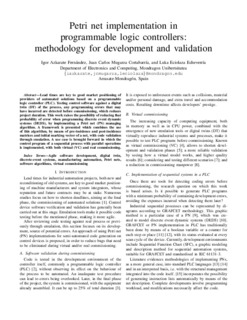
Ver/
Título
Petri net implementation in programmable logic controllers: methodology for development and validationFecha de publicación
2021Versión
PostprintTipo de documento
Contribución a congresoContribución a congresoIdioma
InglésDerechos
© 2021 IEEE. Personal use of this material is permitted. Permission from IEEE must be obtained for all other uses, in any current or future media, including reprinting/republishing this material for advertising or promotional purposes, creating new collective works, for resale or redistribution to servers or lists, or reuse of any copyrighted component of this work in other works.Acceso
Acceso abiertoVersión de la editorial
https://doi.org/10.1109/SAMI50585.2021.9378673Publicado en
IEEE 19th World Symposium on Applied Machine Intelligence and Informatics (SAMI) January 21-23, 2021. Herl'any, Slovakia.Editorial
IEEEPalabras clave
Agile software development
digital twin
discrete-event systems
manufacturing automation ... [+]
digital twin
discrete-event systems
manufacturing automation ... [+]
Agile software development
digital twin
discrete-event systems
manufacturing automation
Petri nets
software algorithms
virtual commissioning [-]
digital twin
discrete-event systems
manufacturing automation
Petri nets
software algorithms
virtual commissioning [-]
Resumen
Lead times are key to good market positioning of providers of automated solutions based on a programmable logic controller (PLC). Testing control software against a digital twin (DT) of the process, a ... [+]
Lead times are key to good market positioning of providers of automated solutions based on a programmable logic controller (PLC). Testing control software against a digital twin (DT) of the process, any programming errors that may have incurred are detected before commissioning, which reduces project duration. This work raises the possibility of reducing that probability of error when programming discrete event dynamic systems (DEDS), by implementing a Petri net (PN) managing algorithm. A framework is presented which combines the use of this algorithm, by means of pre-incidence and post-incidence matrices and initial marking vector of a net, with code validation through emulation. A use case is brought forward in which the control program of a sequential process with parallel operations is implemented, with both virtual (VC) and real commissioning. [-]
Colecciones
- Congresos - Ingeniería [436]




















